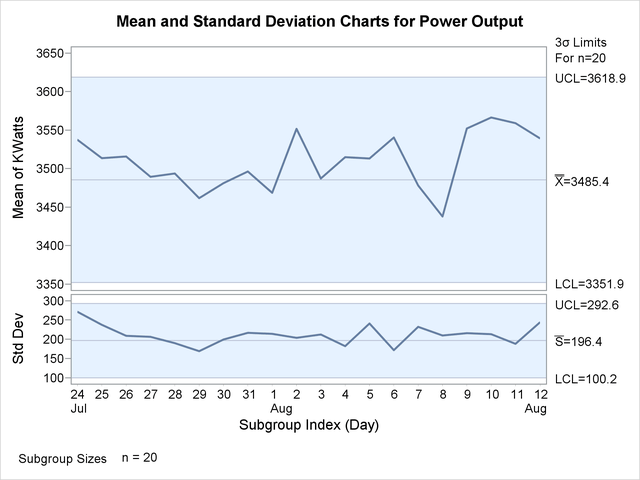XSCHART Statement: SHEWHART Procedure
See SHWXS1 in the SAS/QC Sample LibraryIn the previous example, the OUTLIMITS= data set Turblim saved control limits computed from the measurements in Turbine. This example shows how these limits can be applied to new data. The following statements create ![]() and s charts for new measurements in a data set named
and s charts for new measurements in a data set named Turbine2 (not listed here) using the control limits in Turblim:
ods graphics on; title 'Mean and Standard Deviation Charts for Power Output'; proc shewhart data=Turbine2 limits=Turblim; xschart KWatts*Day / odstitle = title; run;
The ODS GRAPHICS ON statement specified before the PROC SHEWHART statement enables ODS Graphics, so the ![]() and s charts are created by using ODS Graphics instead of traditional graphics. The charts are shown in Figure 17.120.
and s charts are created by using ODS Graphics instead of traditional graphics. The charts are shown in Figure 17.120.
The LIMITS= option in the PROC SHEWHART statement specifies the data set containing preestablished control limit information. By default,[87] this information is read from the first observation in the LIMITS= data set for which
-
the value of
_VAR_matches the process nameKWatts -
the value of
_SUBGRP_matches the subgroup-variable nameDay
The means and standard deviations lie within the control limits, indicating that the heating process is still in statistical control.
In this example, the LIMITS= data set was created in a previous run of the SHEWHART procedure. You can also create a LIMITS= data set with the DATA step. See LIMITS= Data Set for details concerning the variables that you must provide.
[87] In SAS 6.09 and in earlier releases, it is also necessary to specify the READLIMITS option to read control limits from a LIMITS= data set.

